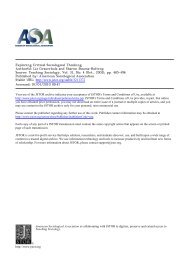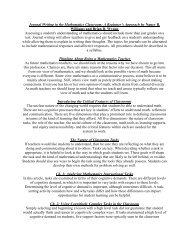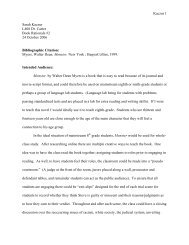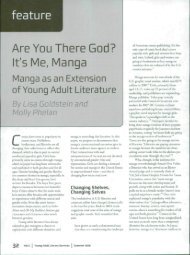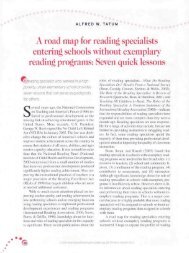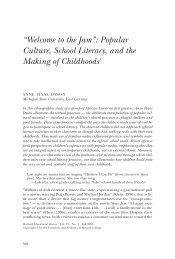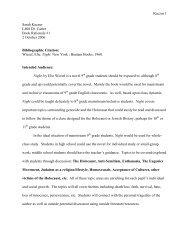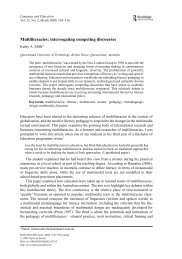Critical Bibliographic Essay Garrett Montgomery 3/25 ... - Oncourse
Critical Bibliographic Essay Garrett Montgomery 3/25 ... - Oncourse
Critical Bibliographic Essay Garrett Montgomery 3/25 ... - Oncourse
You also want an ePaper? Increase the reach of your titles
YUMPU automatically turns print PDFs into web optimized ePapers that Google loves.
<strong>Critical</strong> <strong>Bibliographic</strong> <strong>Essay</strong><br />
<strong>Garrett</strong> <strong>Montgomery</strong><br />
3/<strong>25</strong>/2011<br />
W240<br />
A community system is wild and diverse, comprised of many features and people that<br />
create the culture and identity of the place. Communities, cultures, and societies alike are an<br />
intertwined web that are connected by different nodes and are continually evolving and growing.<br />
They work together and fight each other in a full world system. That is defined as “a social<br />
system, one that has boundaries, structures, member groups, rules of legitimization and<br />
coherence. Its life is made up of the conflicting forces which hold it together by tension, and tear<br />
it apart as each group seeks eternally to remold it to its advantage.” (Wallerstein, 1975) In a<br />
capitalist world, the most powerful single node is one that can control and remold the social<br />
system into what it needs it to be. This world is comprised of billions of nodes of cultural<br />
identity, which can make up larger cultures or breakdown into smaller sub-cultures. This single<br />
node cannot see and perceive what each culture needs to survive. Life within a culture is largely<br />
self-contained, and that the dynamics of its development are largely internal. (Wallerstein, 1975)<br />
A community is self-sustaining and holds onto that through community involvement. However<br />
in recent decades there have been marked declines in civic engagement and social capital.<br />
Attendance and membership from churches to country clubs are on a massive decline and a<br />
world system that does not value small community may be to blame. (Putman, 1996) Real<br />
communities are faltering and truly cannot survive without outside forces interacting with them<br />
continually. The capitalist system may integrate the world economy into a single market; it does
not make the world society homogenous in said market. (Nash, 1981) There is a definite need for<br />
community involvement and structure outside of the world capitalist system to help a community<br />
retain its once self-sustaining attributes. In what ways and how can a community form a othercentered<br />
economy and still adhere to the world system at large?<br />
World systems dependent economies are seemingly everywhere, and most notably in the<br />
United States. The US is a fully globalized economy that makes trade with almost every nation<br />
in the world. (Foreign Trade Data, 2010) Thus, the smaller communities within the US are<br />
dependent the same as the whole. The dependency towards goods and services provided by these<br />
outside sources leaves a crucial weakness in the system. In case of a global crisis, these<br />
necessary items are not available to the community. This apparent lack of subsistence is a<br />
sticking point to the capitalist economy. And it begs the question; do we have any real wealth?<br />
Some communities are working hard to retain self-reliance in their communities they are<br />
involved in. Organizations such as Mother Hubbard’s Cupboard (HUB) in Bloomington, Indiana<br />
are taking strides in that direction by involving community members at all socio-economic levels<br />
to help out the most vulnerable populations in the city. The organization is taking a holistic<br />
approach grass roots approach to reach out to community members and help them become more<br />
secure with their food. The approach includes a food pantry, community gardens, nutrition<br />
education programs, and many more opportunities to help increase civic engagement as well as<br />
subsistence within the community and its individuals. The organization does not just give out<br />
food like many other food banks, but teaches the patrons to become more self-reliant and gain<br />
confidence through workshops and nutritional guidance. These workshops give the patrons a<br />
tangible skill that can be used to help them in the future. Community gardens are a major step<br />
forward in restoring subsistence in a community. The HUB uses the gardens to not only provide
food for the pantry, but use them as a learning tool for the community members. Once again<br />
tangible skills are learned, but also lifestyle choices can be affected. Studies have shown that<br />
community gardeners eat more fresh vegetables than non-gardeners. (Armstrong, 2000) The<br />
patrons are healthier, but also do not need to be dependent on the global economy to bring food<br />
to them. Also, community gardens have generated strong local community involvement with the<br />
inclusion of music, theatre, and storytelling at the sites. (Armstrong, 2000) Increases in social<br />
capital are a result.<br />
Community gardens are a large part of what is called new urbanism and new ruralism.<br />
These concepts stem from the need to have community connectivity to itself as well as the<br />
ecological surroundings. New Ruralism is the preservation and enhancement of rural areas as<br />
places that are indispensable to the economic, environmental, and cultural vitality of cities and<br />
metropolitan regions. (Stratton, 2009) The goal is to prevent sprawl by incorporating the rural<br />
with the urban and use the symbolic relationship between urban and rural areas. The two cannot<br />
survive without each other. Similarly they both suffer from blights; such as sprawl and<br />
industrialized farming that both operating with little regard to the natural conditions of the<br />
landscape and are oblivious to the ecological and cultural uniqueness of a place. (Kraus, 2006)<br />
This uniqueness that is lost by sprawl and industrialized farming needs to be attained again to<br />
give a community identity. The grapes and wines of the world are identified by their place,<br />
Burgundy, Champagne, etc. How come Indiana does not refer to their tomatoes as the Indiana<br />
tomato? The sense of identity and pride through geography where rural lands and connected<br />
within urban influence, allows focus to be on the land as a very valuable commodity.<br />
The start of new ruralism starts with policy that the communities adopt to regulate the<br />
area. The holistic approach far outreaches educating individuals, but reaches the community at
large to make the difference. New Ruralism needs “Smart Code” which integrates land<br />
development, ordinances, and zoning regulations all into one to promote walkable streets and<br />
conservation of open areas, as well as many other conservation designs. (Stratton, 2009) New<br />
Ruralists reconnect with the earth itself and in the process gain a larger sense of community and<br />
self-sustainability. Open lands are preserved as use by wildlife, grazing animals, and medium<br />
sized farming. No longer are the cities sprawling in need of food from the ever growing<br />
industrialized farm, but the people needing the food are neighbors with those who provide it.<br />
Cash crops are not the homogenized norm in the fields, but whatever the community needs and<br />
purchases at the local market are what the farmer provides. The simple supply and demand<br />
functions work not only on a global scale, but on a local scale as well.<br />
Microenterprise and Microdevelopment are economic models used in small developing<br />
countries that do not have much in the means of economic vitality. In Microenterprise small<br />
loans from 50- 5,000 dollars are given to an individual to engage in a self-sustaining business<br />
that operates in the sectors of the small economy. (Karides, 2010) When stepping back a small<br />
town or city may not be much different than a small developing nation. There are major<br />
dependencies on larger economies and outside sources, and very little self-reliance. Can a<br />
community in the US help itself become more self-reliant by giving incentive to its own<br />
members to create and become self-sustaining? In these small situations, if a group of people<br />
borrow money, then others cannot borrow until the money is repaid. The created sense of<br />
responsibility is implicated upon the borrowers by the community and will help ensure loans are<br />
paid back. The sense of accountability given to the dollars in hand help take away from the<br />
imaginary value of the dollar, and give it real value. (Bennholdt-Thomsen, 1999) Renewed sense<br />
of responsibility with money and with the community will help garner subsistence in the
community. The new businesses created and ideas shared can help build up everything needed in<br />
a community.<br />
Community subsistence would hopefully help alleviate the stranglehold the world<br />
economy has on almost all of its inhabitants. In an economy that is solely based on trust that a<br />
piece of paper holds value, holding something that has real value can be lost. However, when<br />
money is greatly needed, can it be trusted to hold its value through unpredictability? With rising<br />
costs of travel and the world’s drunkenness on oil coming to an end, will we have what is needed<br />
in order to survive? This cannot be known, but working with and around the system to create<br />
something better and more sustainable in a smaller community is a way to ensure that if that<br />
imaginary trust were to shatter, there is something solid holding the community up.
Works Cited <br />
Foreign Trade Data. (2010). Retrieved March 22, 2011, from US Census Bureau: <br />
http://www.census.gov/foreign-‐trade <br />
Armstrong, D. (2000). A Survey of Community Gardens in Upstate New York: Implications for Health <br />
Promotion and Community Development. Health and Place, 319-‐327. <br />
Bennholdt-‐Thomsen, V. (1999). The Subsistence Perspective: Beyond the Globalized Economy. London: <br />
Zed Books. <br />
Karides, M. (2010). Theorizing the Rise of Microenterprise Development in Caribbean Context. American <br />
Socialogical Association, 192-‐216. <br />
Kraus, S. (2006). A Call For New Ruralism. Berkeley : Sustainable Agriculture Education. <br />
Nash, J. (1981). Ethnographic Aspects of the Wrold Capitalist System. Annual Reviews, 393-‐423. <br />
Putman, R. (1996). Bowling Alone: Civic Disengagement in America. The American Prospect, 34-‐48. <br />
Stratton, E. (2009). New Urbanism. Athens: Land Use Clinic: University of Georgia. <br />
Wallerstein, I. (1975). The Modern World System. Capitalist Agriculture and the Origins of the European <br />
World Economy in the Sixteenth Century. New York.



